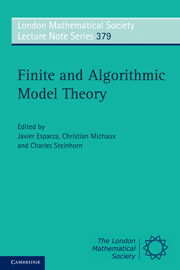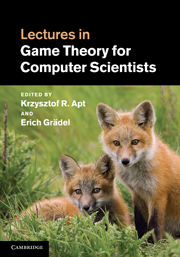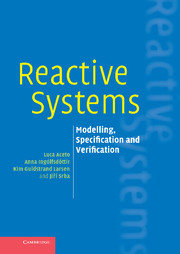Refine search
Actions for selected content:
5849 results in Programming Languages and Applied Logic
REFERENCES
-
- Book:
- Simple Theories and Hyperimaginaries
- Published online:
- 05 March 2012
- Print publication:
- 30 June 2011, pp 163-166
-
- Chapter
- Export citation
CHAPTER 1 - PRELIMINARIES
-
- Book:
- Simple Theories and Hyperimaginaries
- Published online:
- 05 March 2012
- Print publication:
- 30 June 2011, pp 1-10
-
- Chapter
- Export citation
CHAPTER 13 - SUPERSIMPLE THEORIES
-
- Book:
- Simple Theories and Hyperimaginaries
- Published online:
- 05 March 2012
- Print publication:
- 30 June 2011, pp 85-92
-
- Chapter
- Export citation
CHAPTER 11 - CANONICAL BASES
-
- Book:
- Simple Theories and Hyperimaginaries
- Published online:
- 05 March 2012
- Print publication:
- 30 June 2011, pp 69-74
-
- Chapter
- Export citation
CHAPTER 20 - HYPERIMAGINARIES IN SUPERSIMPLE THEORIES
-
- Book:
- Simple Theories and Hyperimaginaries
- Published online:
- 05 March 2012
- Print publication:
- 30 June 2011, pp 153-162
-
- Chapter
- Export citation
CHAPTER 8 - STABLE FORKING
-
- Book:
- Simple Theories and Hyperimaginaries
- Published online:
- 05 March 2012
- Print publication:
- 30 June 2011, pp 47-52
-
- Chapter
- Export citation
Frontmatter
-
- Book:
- Simple Theories and Hyperimaginaries
- Published online:
- 05 March 2012
- Print publication:
- 30 June 2011, pp i-viii
-
- Chapter
- Export citation
CHAPTER 16 - HYPERIMAGINARY FORKING
-
- Book:
- Simple Theories and Hyperimaginaries
- Published online:
- 05 March 2012
- Print publication:
- 30 June 2011, pp 109-120
-
- Chapter
- Export citation
CHAPTER 15 - HYPERIMAGINARIES
-
- Book:
- Simple Theories and Hyperimaginaries
- Published online:
- 05 March 2012
- Print publication:
- 30 June 2011, pp 101-108
-
- Chapter
- Export citation
CHAPTER 3 - Δ-TYPES AND THE LOCAL RANK D(π,Δ,k)
-
- Book:
- Simple Theories and Hyperimaginaries
- Published online:
- 05 March 2012
- Print publication:
- 30 June 2011, pp 19-24
-
- Chapter
- Export citation
CHAPTER 17 - CANONICAL BASES REVISITED
-
- Book:
- Simple Theories and Hyperimaginaries
- Published online:
- 05 March 2012
- Print publication:
- 30 June 2011, pp 121-130
-
- Chapter
- Export citation
CHAPTER 10 - THE INDEPENDENCE THEOREM
-
- Book:
- Simple Theories and Hyperimaginaries
- Published online:
- 05 March 2012
- Print publication:
- 30 June 2011, pp 63-68
-
- Chapter
- Export citation
INDEX
-
- Book:
- Simple Theories and Hyperimaginaries
- Published online:
- 05 March 2012
- Print publication:
- 30 June 2011, pp 167-169
-
- Chapter
- Export citation
CHAPTER 5 - INDEPENDENCE
-
- Book:
- Simple Theories and Hyperimaginaries
- Published online:
- 05 March 2012
- Print publication:
- 30 June 2011, pp 31-36
-
- Chapter
- Export citation
CHAPTER 18 - ELIMINATION OF HYPERIMAGINARIES
-
- Book:
- Simple Theories and Hyperimaginaries
- Published online:
- 05 March 2012
- Print publication:
- 30 June 2011, pp 131-142
-
- Chapter
- Export citation
CHAPTER 9 - LASCAR STRONG TYPES
-
- Book:
- Simple Theories and Hyperimaginaries
- Published online:
- 05 March 2012
- Print publication:
- 30 June 2011, pp 53-62
-
- Chapter
- Export citation
CHAPTER 19 - ORTHOGONALITY AND ANALYSABILITY
-
- Book:
- Simple Theories and Hyperimaginaries
- Published online:
- 05 March 2012
- Print publication:
- 30 June 2011, pp 143-152
-
- Chapter
- Export citation

Finite and Algorithmic Model Theory
-
- Published online:
- 01 June 2011
- Print publication:
- 10 March 2011

Lectures in Game Theory for Computer Scientists
-
- Published online:
- 01 June 2011
- Print publication:
- 06 January 2011

Reactive Systems
- Modelling, Specification and Verification
-
- Published online:
- 17 March 2011
- Print publication:
- 09 August 2007
